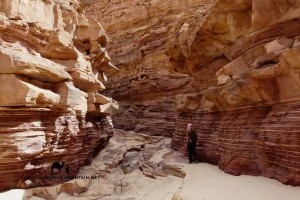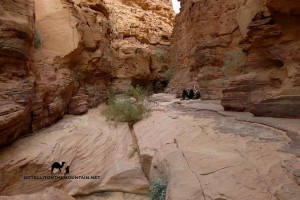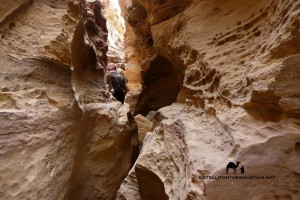March 12, 2015
The secret canyon: Abu Hamata
 Over the years I’ve been walking the Sinai and talking to the Bedouin, I’ve heard a few stories about a little-known canyon, hidden deep in one of the most remote parts of the peninsula. Some said it was the Sinai’s longest canyon. Others said it was the most beautiful. Whoever described it gave it an air of secrecy and mystique. Known as Abu Hamata – Place of the Wild Figs – it’s a spot only a few Bedouin know. Yesterday, I went to check it out with Leo – a guy who’s just returned from an epic, month-long walkabout in the Sinai – and a Bedouin friend of the Jebeleya tribe from St Katherine, who’s also a two-time Abu Hamata veteran.
Over the years I’ve been walking the Sinai and talking to the Bedouin, I’ve heard a few stories about a little-known canyon, hidden deep in one of the most remote parts of the peninsula. Some said it was the Sinai’s longest canyon. Others said it was the most beautiful. Whoever described it gave it an air of secrecy and mystique. Known as Abu Hamata – Place of the Wild Figs – it’s a spot only a few Bedouin know. Yesterday, I went to check it out with Leo – a guy who’s just returned from an epic, month-long walkabout in the Sinai – and a Bedouin friend of the Jebeleya tribe from St Katherine, who’s also a two-time Abu Hamata veteran.
Getting there isn’t easy. It’s in a little-known tract of desert below Hadabat el Tih, the gigantic table land that runs from one side of the Sinai to the other, forming the great natural divide betwen North Sinai and South.
Rain that falls north of the plateau’s edge runs down to the Mediterranean.
Rain that falls to the south – into canyons like Abu Hamata – runs either to the Gulf of Aqaba or the Gulf of Suez.
As wilderness settings for a canyon go, this is about as good as it gets.
 The wilderness that surrounds Abu Hamata makes the whole thing more of an adventure. Doing a canyon in the middle of nowhere will always be more exciting to me than doing one that’s easy to get to. And the wilderness doesn’t just add adventure: it has a sort of moat-around-the-castle effect that has fortified it against the mass tourism that has been so harmful to some of the Sinai’s other canyons. There’s a stillness and solitude and peace in this place that it’s hard to find in other spots. Entering it feels like walking into a gigantic natural cathedral or mosque.
The wilderness that surrounds Abu Hamata makes the whole thing more of an adventure. Doing a canyon in the middle of nowhere will always be more exciting to me than doing one that’s easy to get to. And the wilderness doesn’t just add adventure: it has a sort of moat-around-the-castle effect that has fortified it against the mass tourism that has been so harmful to some of the Sinai’s other canyons. There’s a stillness and solitude and peace in this place that it’s hard to find in other spots. Entering it feels like walking into a gigantic natural cathedral or mosque.
Coming from the St Katherine or Dahab side you follow a long, winding jeep track over harsh sandstone badlands before reaching a single palm tree in a long, sandy wadi, which marks the point you start walking.
To begin, the walk-in to the canyon is nothing spectacular.
Further up, the walk is interrupted by a small waterfall cliff near some wild fig trees. The canyon takes its name from these. Scramble over this cliff and you can continue in the sandy wadi until you reach a point that looks like a cul-de-sac.
Carry on though and you’ll see it’s no cul-de-sac at all. It’s a sharp turn to the left: and when you round it the canyon stretches out ahead: Abu Hamata.
 It begins as a narrow passageway of red rock. Walk in and the temperature drops. It gets dark and shadowy. Dry polygons of sand crack under your feet. There are big dips in the floor that once held pools of water, and the canyon twists and turns, getting so narrow that you have to take a deep breath in and squeeze through in some places. You have to scramble all the way along – there’s no easy walking. At one point there’s a tricky step that counts as a rock climbing move: a vertical waterfall drop of about two metres – smooth and bereft of good holds – where a lot of hikers would need the assistance of an experienced guide and rope to pass.
It begins as a narrow passageway of red rock. Walk in and the temperature drops. It gets dark and shadowy. Dry polygons of sand crack under your feet. There are big dips in the floor that once held pools of water, and the canyon twists and turns, getting so narrow that you have to take a deep breath in and squeeze through in some places. You have to scramble all the way along – there’s no easy walking. At one point there’s a tricky step that counts as a rock climbing move: a vertical waterfall drop of about two metres – smooth and bereft of good holds – where a lot of hikers would need the assistance of an experienced guide and rope to pass.
One of the best things about Abu Hamata is it just keeps going.
Every time you think it’s about to end a new twist in the canyon reveals a whole new stretch, running out ahead. Towards the end the walls drop gradually in height until you clamber out of the narrow slot to enter a more open wadi. From the wadi sides here, you can gaze over a beautiful panorama of Hadabat el Tih: the high table land stretching faraway into the distance.
This spot is also where you’ll be able to meet your driver again.
The branch of Abu Hamata we did isn’t the only one. Another one cuts off on the left side of the sandy wadi you start in, which is said to be spectacular too. We didn’t do it this time but it’s been chalked onto my ever-growing list. Anyway, check out a Google Maps image showing the start and finish points of the Abu Hamata canyon we did (bottom of this post). It’ll give you a sense of how to do it yourself. Please though, if you do go to this place, remember a few things.
 First of all, this is one of the most little-visited canyons in the Sinai. Which is part of why it’s so beautiful and precious. There’s no rubbish. No graffiti. Please don’t be the first to leave it. Don’t forget the canyon has a tricky climbing step – for which you’ll need a guide and maybe rope equipment – and make sure you have a driver who knows the way and who has both the vehicle and stomach for the ride. Youssuf – the driver I use – is a guy you can rely on in any part of South Sinai. You can find out more about him in my Directory of the Best and you can call him on 0109-717-2211. Thanks to Leo Laimer for his photos in this piece.
First of all, this is one of the most little-visited canyons in the Sinai. Which is part of why it’s so beautiful and precious. There’s no rubbish. No graffiti. Please don’t be the first to leave it. Don’t forget the canyon has a tricky climbing step – for which you’ll need a guide and maybe rope equipment – and make sure you have a driver who knows the way and who has both the vehicle and stomach for the ride. Youssuf – the driver I use – is a guy you can rely on in any part of South Sinai. You can find out more about him in my Directory of the Best and you can call him on 0109-717-2211. Thanks to Leo Laimer for his photos in this piece.